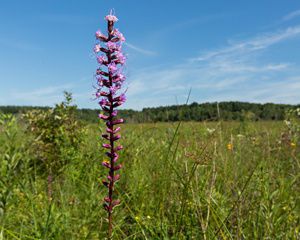
Wild Rice Planting The Nature Conservancy joins the Keweenaw Bay Indian Community in planting wild rice in Michigan's Northwoods. © Nick Mead/TNC
On a sunny September day last year, The Nature Conservancy joined staff from the Natural Resources Department of the Keweenaw Bay Indian Community (KBIC) at a wetland in a TNC forest reserve to plant wild rice.
Found in shallow waters of inland lakes, slow-flowing streams, and Great Lakes embayments, wild rice has ecological, social, cultural and economic value in the state, particularly for Anishinaabe communities, who know the plant as manoomin or mnomin, translated as “good berry.”

Prior to the 1900s, wild rice was plentiful in Michigan waterways. The only native grain in the Great Lakes region, it was a key reason Indigenous communities settled here and successfully harvested the plant for millennia. They learned that it could be dried and stored for long periods of time, providing healthy meals when other food was scarce.
Wild rice can be harvested through traditional methods that typically involve canoes, which do little damage to wild rice, and ricing sticks. Harvesters pull the stalks over the gunwale and knock the kernels into the canoe. Rice must be almost immediately dried, then parched, hulled and winnowed. Traditionally harvested wild rice has a unique, nutty flavor, is high in protein, and is delicious in a variety of meals as a side or main dish.
Over the past two centuries, habitat loss, damming, pollution, uninformed harvesting practices, climate change and other factors nearly wiped out the wild rice population. The plant has specific habitat requirements, including clean, slow-moving water at relatively stable shallow depths. Its future is threatened by climate change, the increased volatility of weather events, their impacts on water depth, current and clarity, lakeshore riparian practices and improper harvesting.
That’s why Tribal nations, natural resource agencies and partners are working restore wild rice and educate people about its importance through initiatives like the Michigan Wild Rice Initiative and the Great Lakes Indian Fish and Wildlife Commission’s Manoomin program.

Manoomin (Zizania palustris and Zizania aquatica), also known as Michigan wild rice, was designated as the official native grain of Michigan in 2023.
In 2023, Michigan designated wild rice as its state grain.
“Manoomin (Zizania palustris and Zizania aquatica), also known as Michigan wild rice, is designated as the official native grain of this state. Let it be known that manoomin is a sacred and important component to many wetlands and has a cultural significance to Indigenous people of this state,” read PA 247 of 2023, passed as part of a deliberate effort, by Tribal nations and state and federal agencies to raise awareness of wild rice conservation.
Help Protect Michigan's Biodiversity
You have the power to make a difference for the Great Lakes State and for our planet.
Support Our WorkSince the 1990s, the KBIC and its partners have been working to increase the presence of wild rice across the Western Upper Peninsula. As part of this effort to restore wild rice to the waters of the Great Lakes region, TNC and KBIC Natural Resources staff met to determine suitable planting locations on nearby TNC lands, settling on an acre of wetland within a TNC forest reserve in the Upper Peninsula of Michigan.
Wild rice grows in six inches to three feet of water, and grows best in the middle of that range, according to the Great Lakes Indian Fish and Wildlife Commission. It requires the presence of flowing water, so there must be an inlet and outlet to the water body.

Loading two canoes with wet wild rice seed, three TNC staff and a habitat specialist from KBIC paddled the wetland and dispersed the seeds by casting them out across the water by hand.
“We paddled around the wetlands tossing handfuls of wild rice into the water,” says Chris Cantway, TNC restoration associate. “It was a beautiful day on the water.”
It was the first planting in a long-term effort to establish native wild rice beds within the reserve. Wild rice is an annual plant, so annual seeding and harvesting are needed to increase the likelihood of establishment.
This August, TNC returned to the wetland to check on last year’s results and do a new round of planting. On another beautiful late summer day, three TNC staff received wild rice seed from KBIC staff and then paddled, pushed, and poled a canoe and a kayak loaded with wild rice seed up a narrow inlet through thick wetland vegetation to the site of last year’s planting.
“We are just beginning to learn about manoomin as a relative from our Tribal partners. It serves as an important plant for wetland structure and function, food for people and wildlife, and has great cultural importance within our waterways in Michigan,” says Emily Clegg, TNC director of land and water management in Michigan.
TNC’s forest reserves provide homes for threatened, endangered, and rare species in the Northwoods. If this restoration effort is successful, they could also be a home to the region’s only native, delicious grain.

Looking for More Ways to Get Involved?
Sign up to receive monthly conservation news and updates from Michigan. Get a preview of Michigan’s Nature News email.


